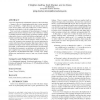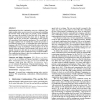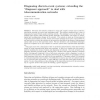396 search results - page 66 / 80 » How scientific models can explain |
SIGCOMM
2006
ACM
14 years 1 months ago
2006
ACM
A pervasive requirement of distributed systems is to deal with churn — change in the set of participating nodes due to joins, graceful leaves, and failures. A high churn rate ca...
ICFP
2005
ACM
14 years 7 months ago
2005
ACM
Implementing first-class continuations can pose a challenge if the target machine makes no provisions for accessing and re-installing the run-time stack. In this paper, we present...
CEC
2010
IEEE
13 years 8 months ago
2010
IEEE
Computational science is placing new demands on optimization algorithms as the size of data sets and the computational complexity of scientific models continue to increase. As thes...
ISF
2010
13 years 6 months ago
2010
As more and more companies are deploying, or plan to deploy, information systems, the organizational capabilities to effectively deploy information technologies to support and shap...
DEDS
2002
13 years 7 months ago
2002
Abstract. Detection and isolation of failures in large and complex systems such as telecommunication networks are crucial and challenging tasks. The problem considered here is that...



